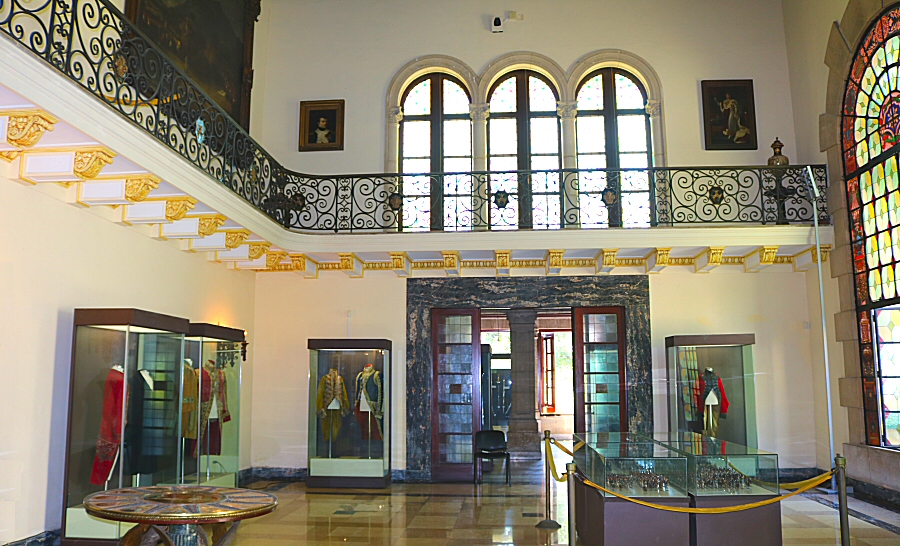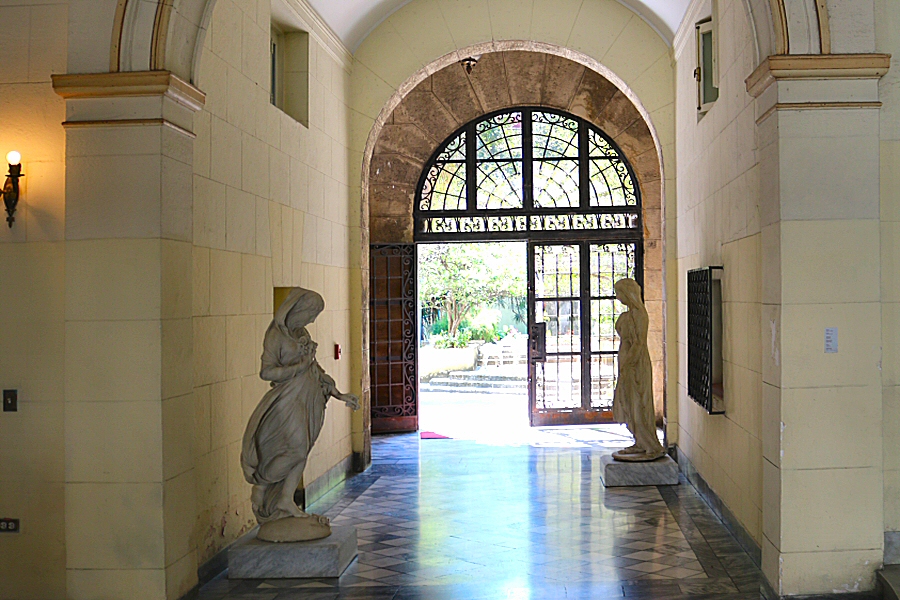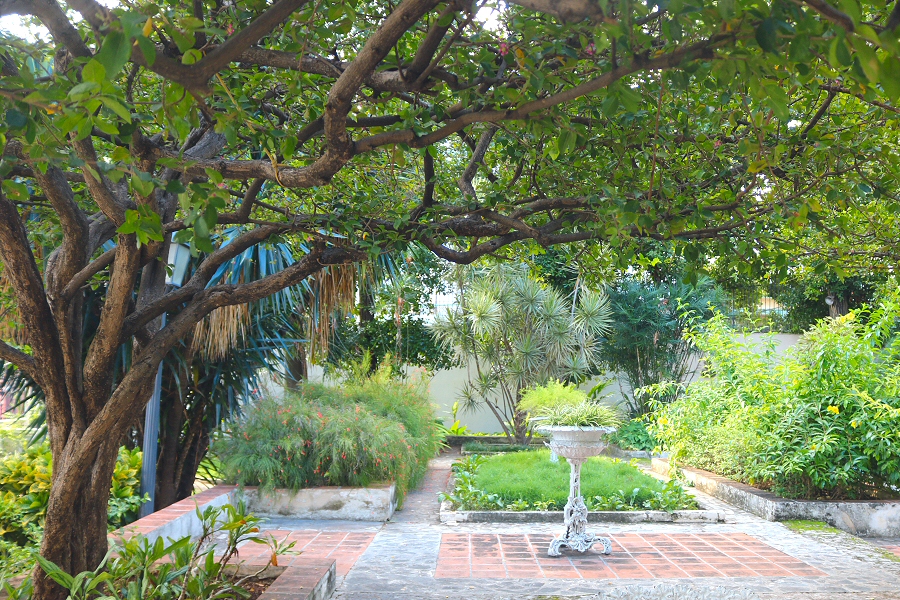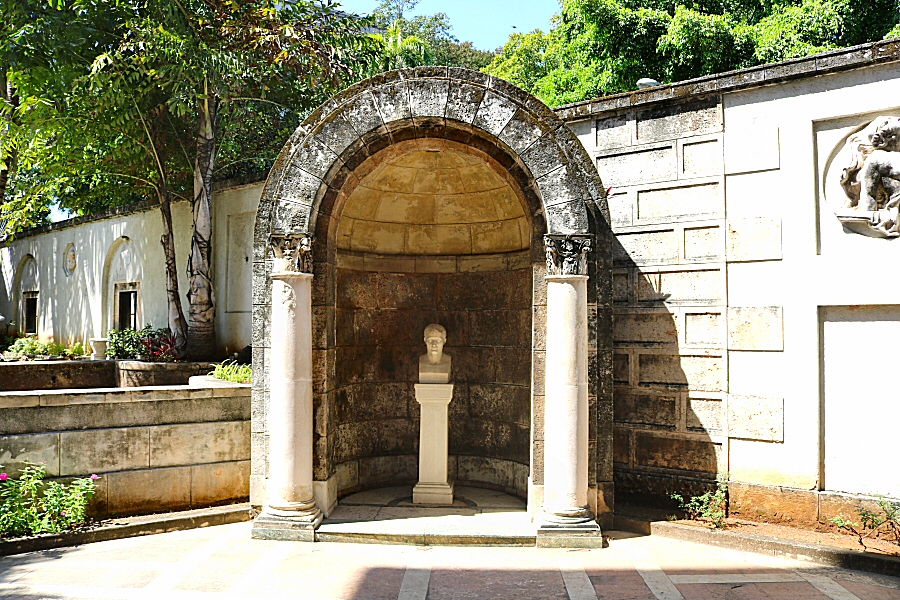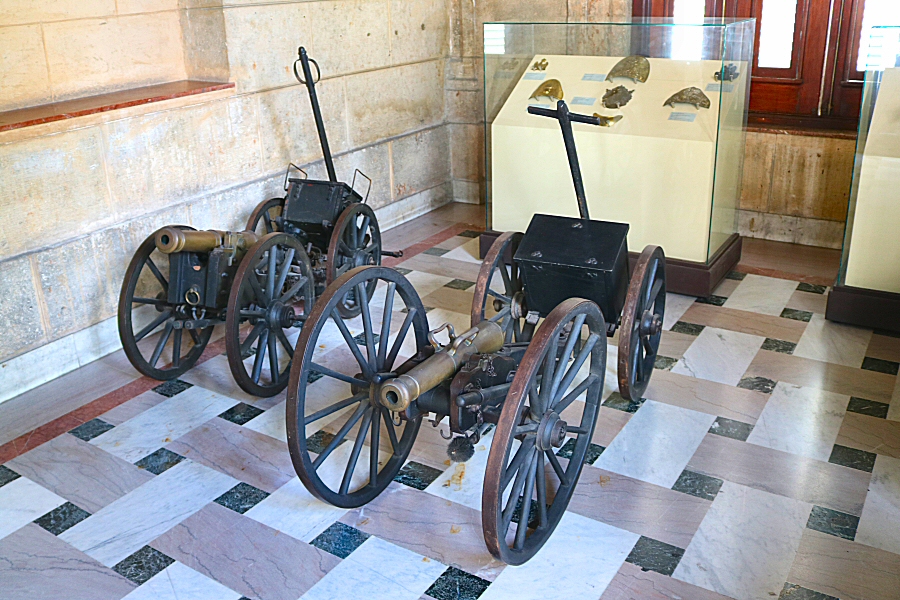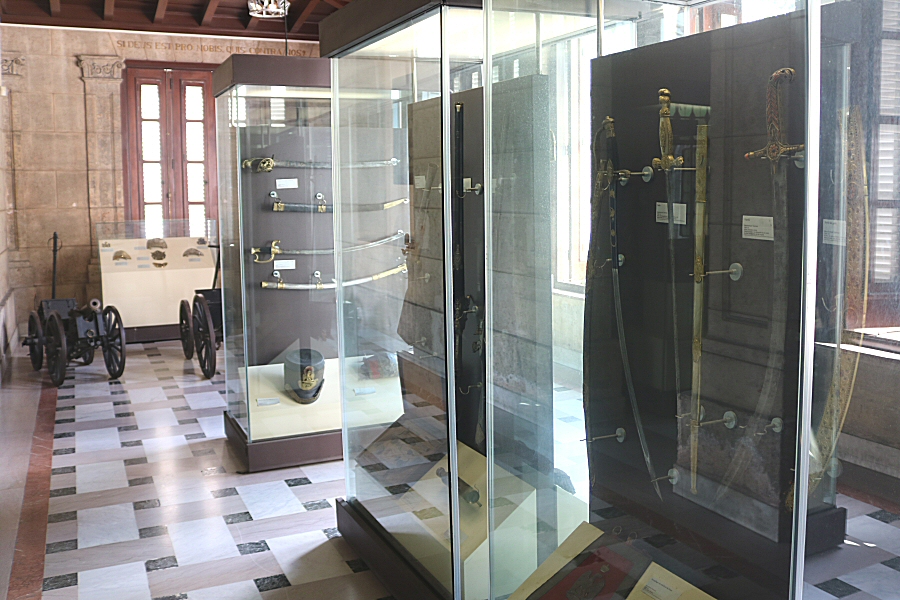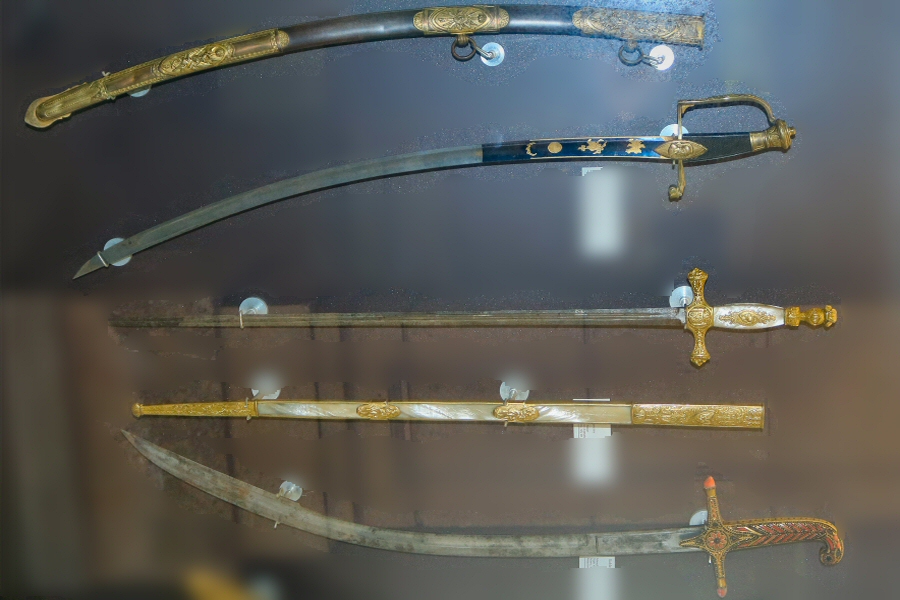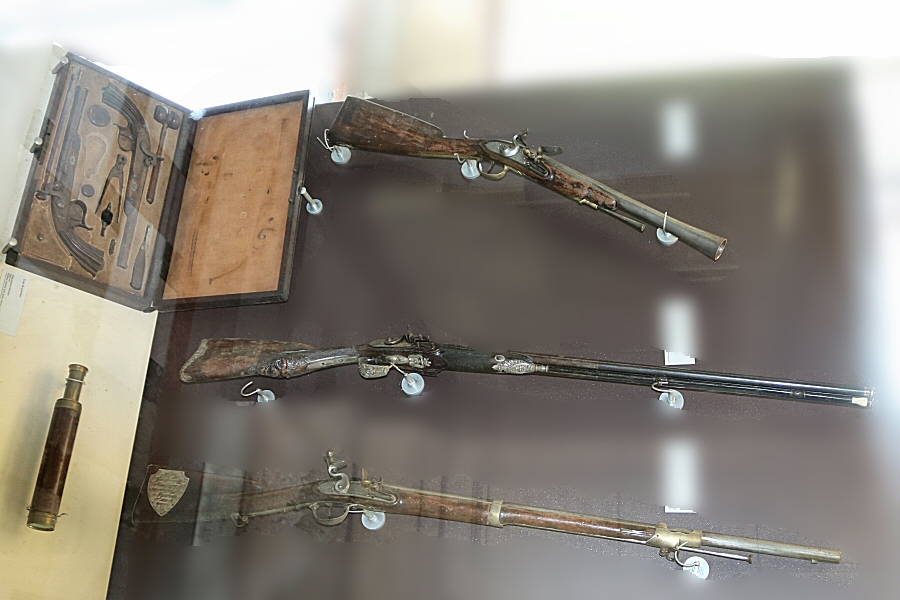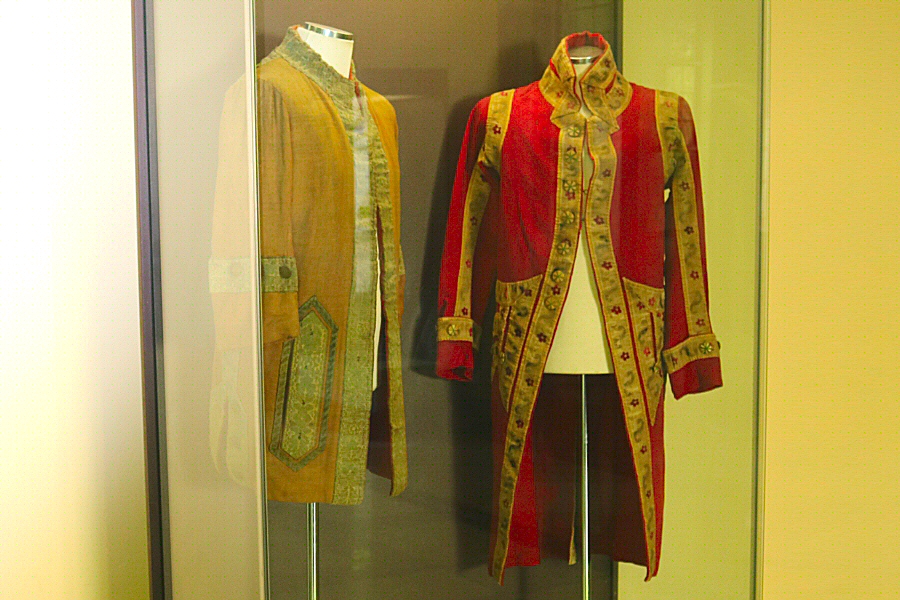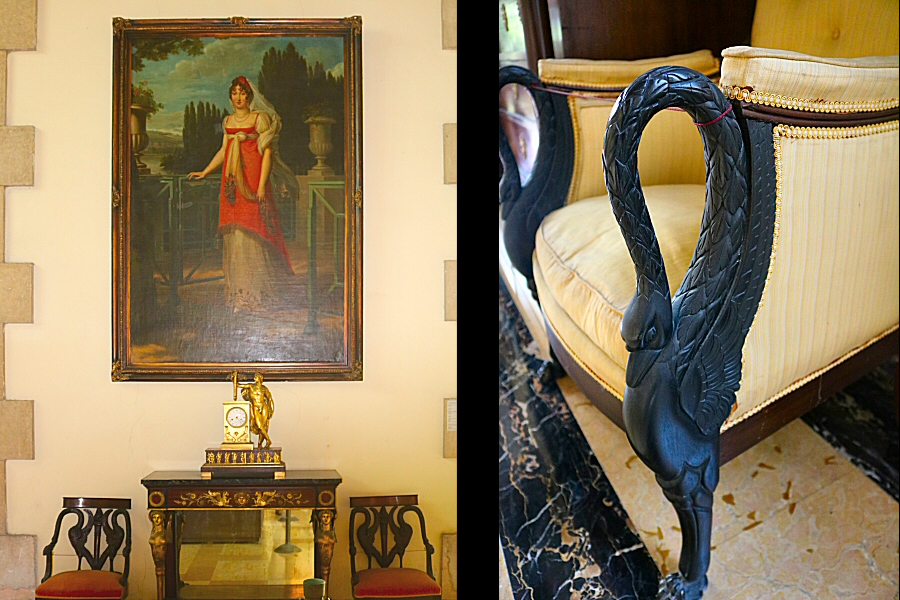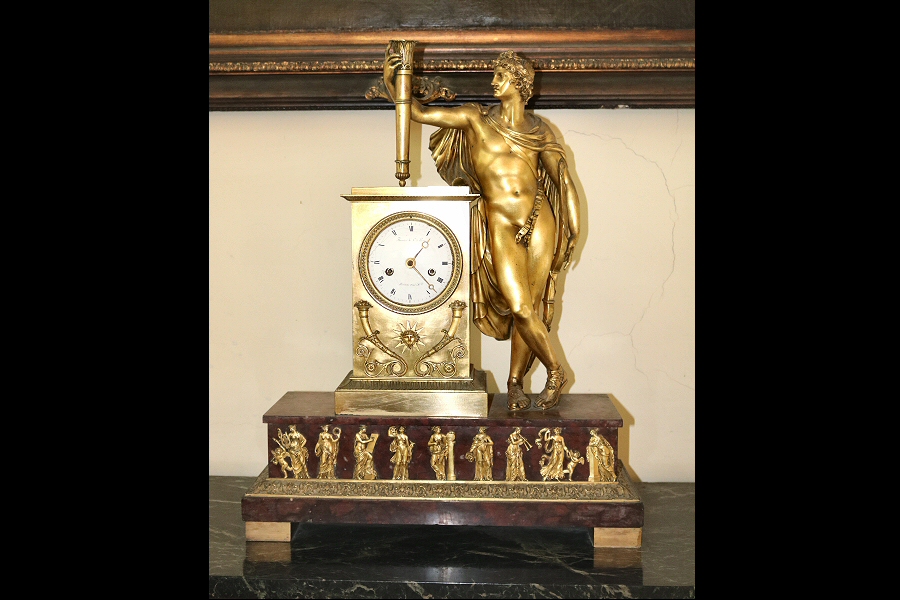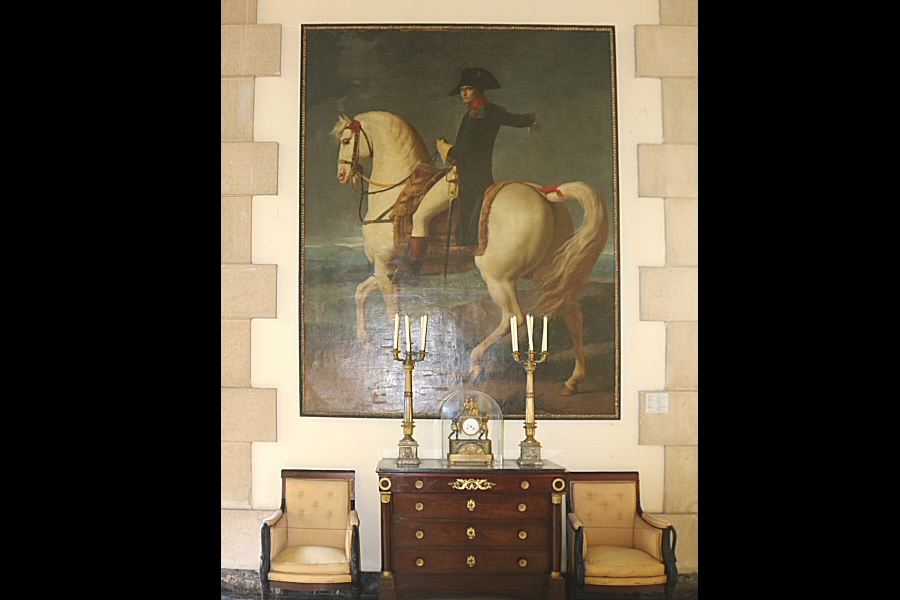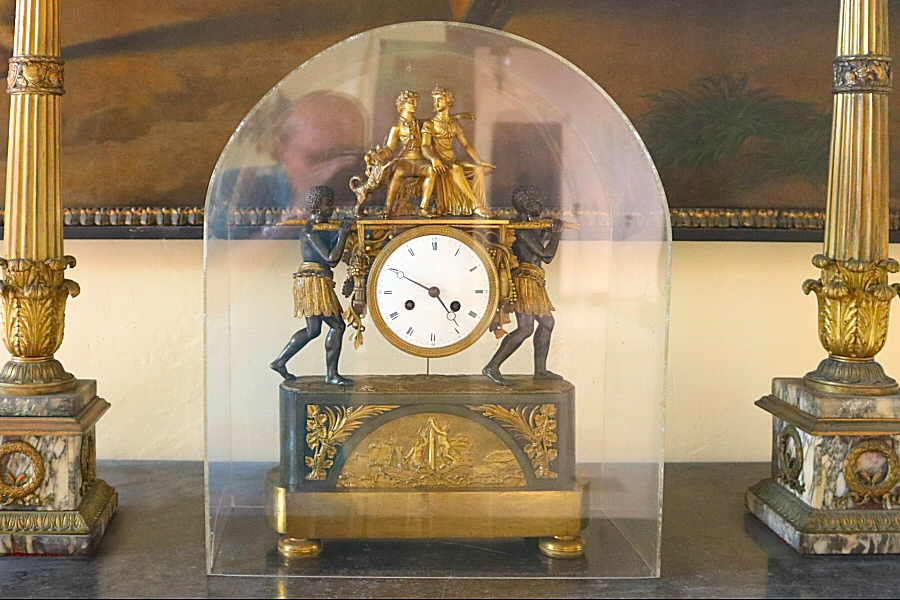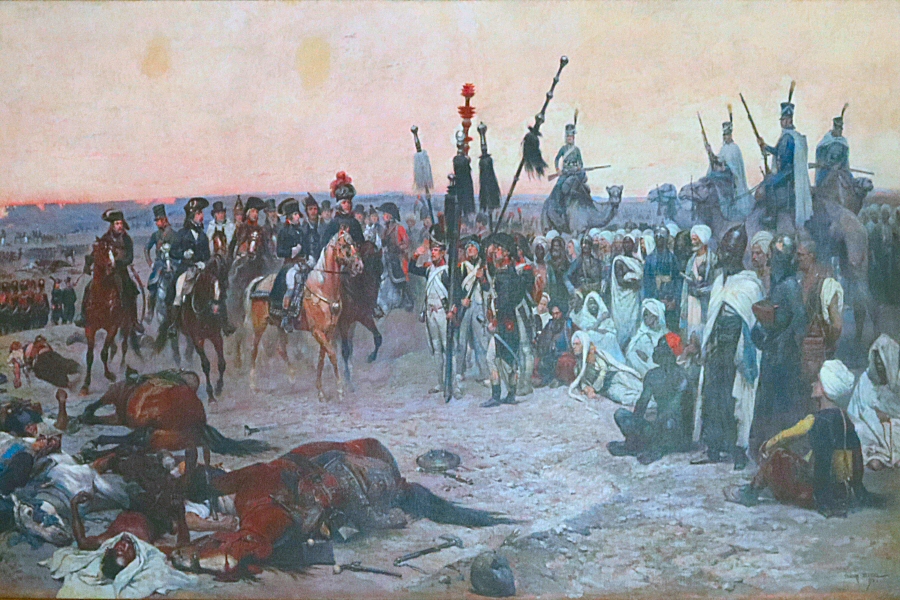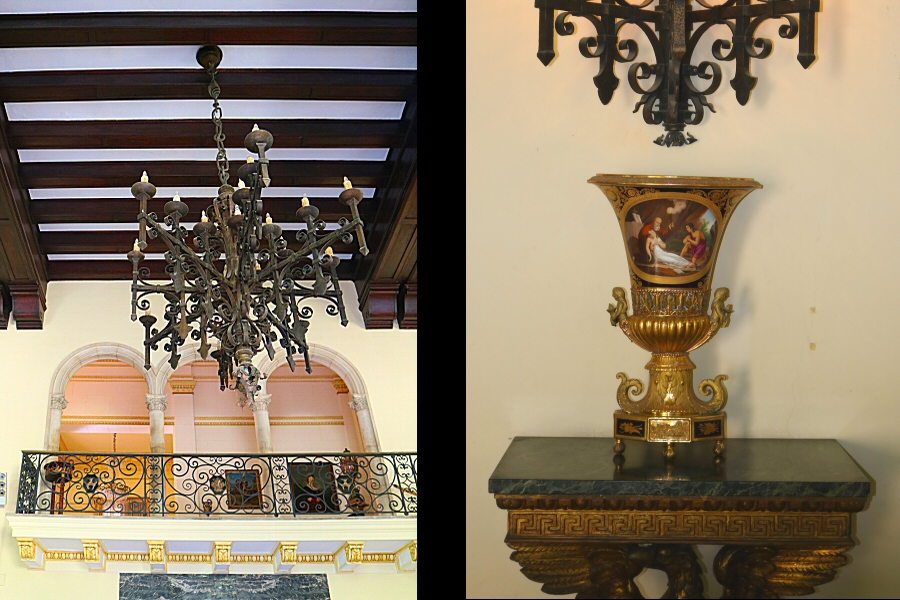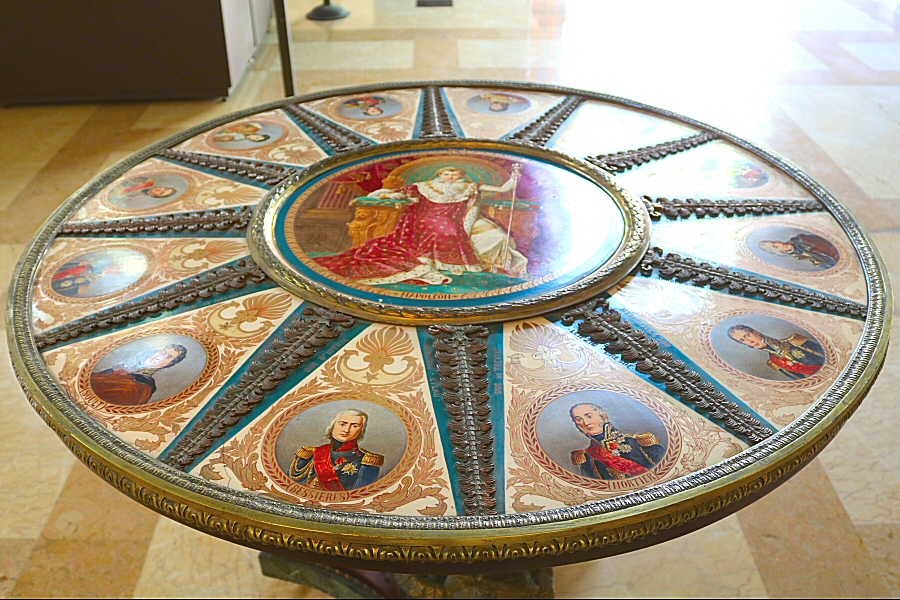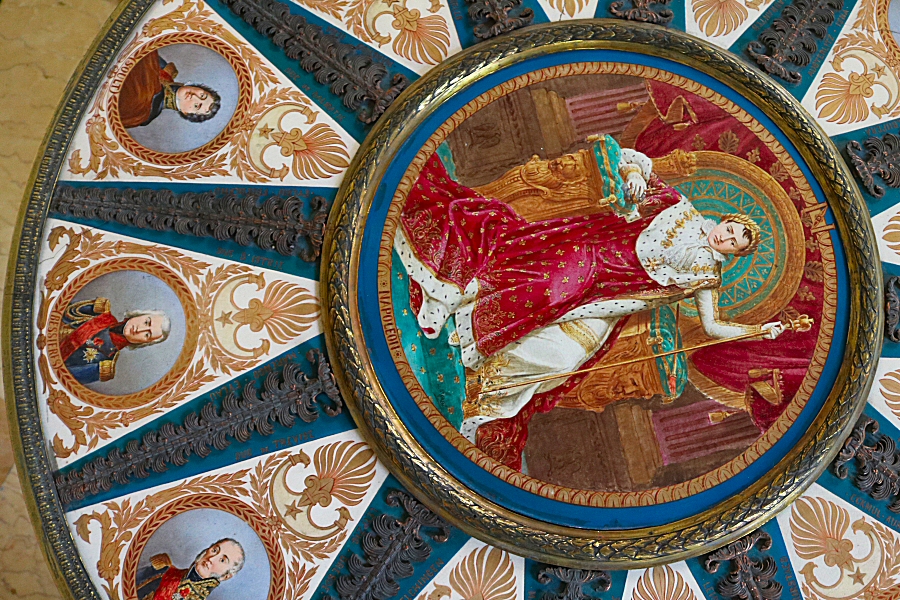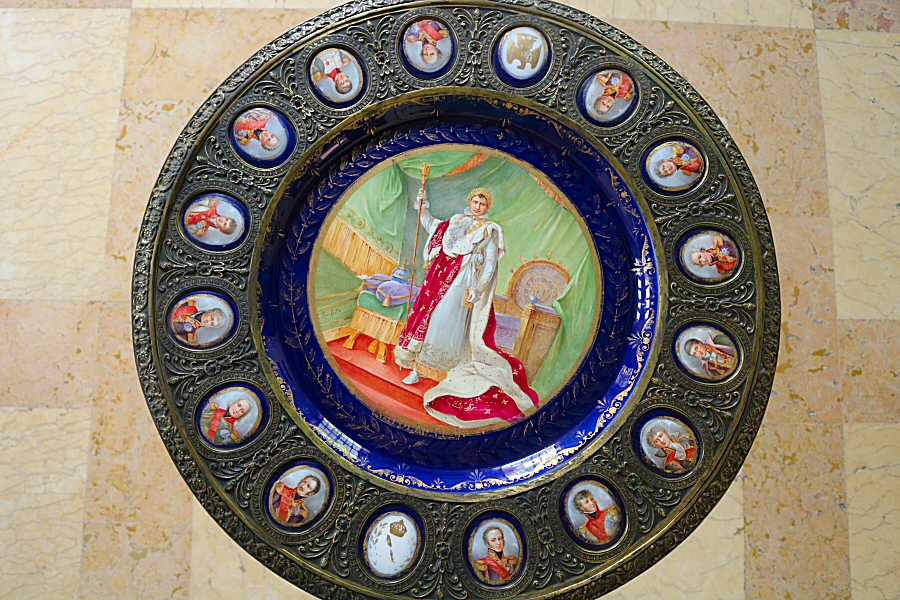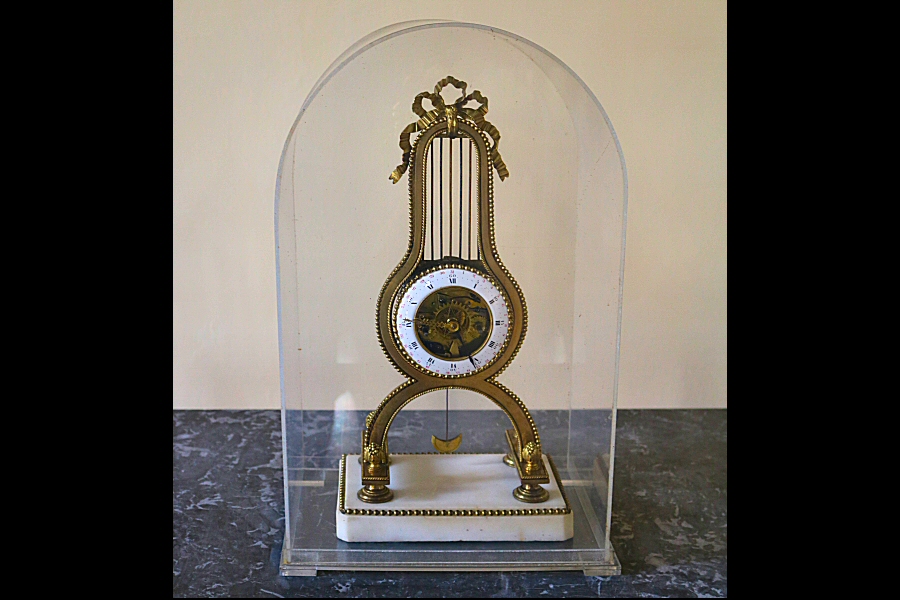
On the ground floor, the long corridor after
the main entrance on the San Miguel street brings you to a patio
with dense vegetation and a pool, or you can access the Grand
Salón of the museum, passing through the small lobby. The Grand
Salón opens to a well-kept garden where you can find a marble
bust of Napoléon. It is the copy of the work, sculpted by the
French sculptor Antoine-Denis Chaudet. The original was damaged
by some vandals in 2018, when it was on the exhibition as the
loan of the Louvre Museum in Arc de Triomphe, Paris. When the
artist received the order to sculpt a statue of Napoléon
Bonaparte, he completed first his original bust in 1804. Later,
many copies of this bust were made from the plaster cast of this
bust, before it was sent to Carrera.
On the ground floor there are also the
chapel and the kitchen.
The spacious Grand Salón is illuminated by
the sunlight, entering through giant splendid stained-glass
windows that look to the lateral garden. The pavement is made of
well-polished honey-colored marble. The Grand Salón can be
watched also from the inner balconies of the second floor that
has fancy iron railings. The first half of the Grand Salón is
surrounded by showcases, in that some military uniforms,
different liveries of the French Imperial Palace and the deep
red coat of the judge of Napoléon’s time are exhibited. There is
also a flamboyant coat, made of felt and cotton, that Napoléon
has worn in Brussel in 1803.
The adjoining room is dedicated to the
weapons, like the pistols and the swords. Among the sword
collection, the saber of Joachim Murat and the swords of Marshal
Lannes are outstanding. The scabbard of the sword of
Marshal Lannes is ornamented with nice silver embossments.
Napoléon’s close friend Marshal Lannes is known by his victory
at the Battle of Tudela during the Peninsular War. The steel
saber of Joachim Murat, the Marshal and Admiral of France during
the First Empire, has an elaborate, gilt bronze scabbard. Both
are engraved with the inscription “Mre. Ré de Napoli”. The
saber looks like a Turkish sword. Joachim Murat, also the King
of Naples, was married to Napoléon’s younger sister, Caroline
Bonaparte.
The firearm collection contains the Borodino
pistols and the DeBoubert double barrel shotgun. The Borodino
pistols were carried by Napoléon during the Russian Campaign in
1812. The bloody battle between the French and Russian armies
occurred in Borodino, 75 km west of Moscow. The pistols were
manufactured by LePage in Paris. Napoléon gave the pistols to
Duke de Vincenza, as written on the pistol barrel. The mentioned
Duke de Vicence is Armand Augustin Louis, Marquis de
Caulaincourt that had great contribution in the decision of
Napoléon to invade Russia. The double barrel shotgun was
manufactured by DeBoubert in 1814. It is a product of refined
taste, as it is ornamented with several silver motifs, like
swans, satyrs and a winged Victory wearing a thistle. The wood
part is carved in the shape of a satyr with a long moustache.
The tin soldiers in the display case that
represent the French army of Bonaparte’s time, are worth to have
a look closely.
On the wall between the windows looking to
the lateral garden, you will see the oil painting of Carolina
Bonaparte (Murat), the younger sister of Napoléon Bonaparte and
the Queen of Naples. It was painted by the French painter Baron
François Pascal Simon Gérard in 1808. Such large portraits were
in vogue in the decoration of the palatial houses
Below the painting, there is the imperial
style console, made of mahogany and oak. A black marble is
placed on the top of the console. It is the work of the renowned
cabinetmaker Jacob D.R. Meslé, but the bronze ornaments are the
work of Pierre Philippe Thomire, the most prominent producer of
gilt-bronze objects and furniture mounts of the Bonaparte’s
time.
On the console, a bronze French
table clock with Apollo from the 19th century (1825-1830) stands
out. It is the work of the skillful clockmaker (horologist)
Louis Moinet l'Aîné, but
the bronze work belongs to
Pierre Philippe Thomire. Apollo, the
Greek God of Sun, Light, Music and Prophecy, is represented
holding a bow with his left hand (also God of Archery) and a
torch with his right hand (God of Light). On the base of the
clock, there are the bronze embossments of the nine Muses.
Apollo was their leader.
At each side of the console, there are two
chairs with swan neck figures on their back rest. The wooden
part of the Italian chairs from the 19th century is made of
mahogany and the seat part of velvet. There is also another
console from the 18th century with similar black marble at the
top. A crater-shaped vase from the 19th century that is
allegoric with the novel of the French writer, diplomat and
politician François-René de Chateaubriand, is placed on the
console. The console is made in Britain and the vase in Paris.
In the center of the hall, a round table, adorned with
engravings and with colorful pictures of Napoléon Bonaparte’s
marshals, stands out.
The last half of the Grand Salón is
symmetrical with the first half, as it has similar decoration
design: a wooden console with a table clock, two chairs at both
side of it and an oil painting above the console. Napoléon
Bonaparte is represented on his horse in the oil painting, hung
between the gigantic stained-glass windows. It is the work of
the French painter Jean Baptiste Regnault that made it in 1804.
The title of the painting is "Napoléon au camp de Boulogne".
Below the painting, there is a console with drawers, on that a
table clock stands. Two big candelabras are accompanying the
table clock.
The table clock dates to about 1800-1805,
and it is likely the work of the French Pierre-Francois-Gaston
Jolly. It references the novel "Paul et Virginie" by
Jacques-Henri Bernardin de Saint-Pierre, first published in
1788. The story takes place in Mauritius, when the island was
under French rule. The novel's title characters are loving each
other since their birth. However, the artificial sentimentality
of the French upper classes in Mauritius in the 18th century,
based on social class divisions, destroys their life.
On the top of the clock, the figures of Paul
and Virginie are carried on a palanquin by two native Indians.
The scene in that Paul and Virginie are shipwrecked on
Mauritius, is represented on a plaque in front of the clock, in
that the glittering sea is simulated by a colored glass. The
artist also added a dog to the figures that symbolizes the
fidelity. This mantle clock is the smaller version of the clock,
manufactured by Pierre-Philippe Thomire for Napoléon in 1802.
However, the Emperor was so impressed by the novel, so that he
gave the clock to its author, Jacques Henri Bernardin de
Saint-Pierre. The clock that you see here is almost identical
version of Thomire’s clock, whereas the latter is on the
exhibition in the Musée François Duesbert at Mons, Paris.
The Grand Salón contains an important oil
portrait of Napoléon Bonaparte, depicting him, when he was in
Milan shortly after the victory in Marengo. In the painting,
Napoléon is wearing the Marengo uniform that is exhibited in the
Musée des Invalides in Paris. It is the work of the Italian
painter Andrea Appiani that was in the crowd, welcoming the
Emperor in Milan. He gained the sympathy of
Napoléon in a short
time, so that he called Appiani the First Painter in 1805. He
made a lot of portraits of Napoléon Bonaparte; this oil portrait
that you see in the museum, is likely to be the first one.
The consulate writing table in the Grand
Salón has delicate swan handles that support the tabletop. The
swan figure was almost the elementary ornament in the Empire
period. Swans were everywhere, as painted onto porcelain, carved
into wood or printed onto textiles. It was a symbol also
associated with Joséphine de Beauharnais. The museum has a lot
of objects with swan figure; the most outstanding one is the
armchair with swan arms on the second floor that belonged to
Joséphine.
There are two more big size oil paintings in
the Grand Salón: the oil painting by Jean Baptiste Edouard
Detaille that depicts Napoléon during the occupation of Egypt,
and the oil painting by Jacques François Joseph
Swebach-Desfontaines, entitled "The Battle of Mount Tabor".
The former oil painting was made 80 years
after the battle of the Nile during the Egyptian Campaign in
1798-1801. Napoléon is represented on his horse, riding up to
the smeared Mamaluk’s soldiers. The armed French soldiers are
depicted on camels, making a reference to the complete defeat of
Mamaluks.
In the latter oil painting, Napoléon is
represented on his horse, directing his soldiers to the
battlefield. In this battle that occurred in 1799, the French
could not proceed due to the repeat attacks of the Ottomans that
were outnumbering the French. When the French were low on
ammunition, food and water, Napoléon ordered to destroy the
camps of the Ottomans by a troop of only 300 soldiers. When the
Ottomans saw that their camps were destroyed, they assumed that
they were surrounded by the French. This led to the retreat of
the Ottomans.
